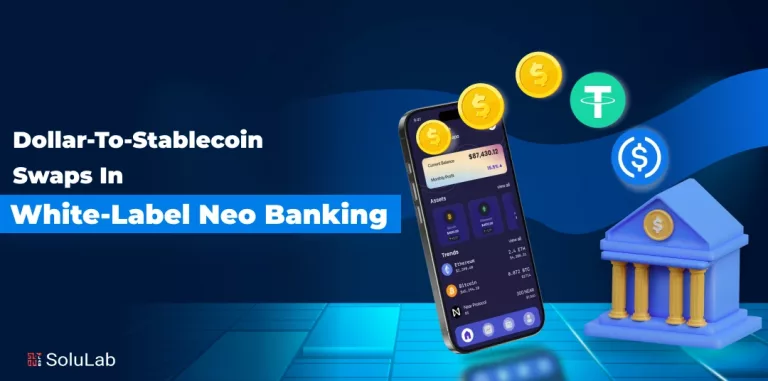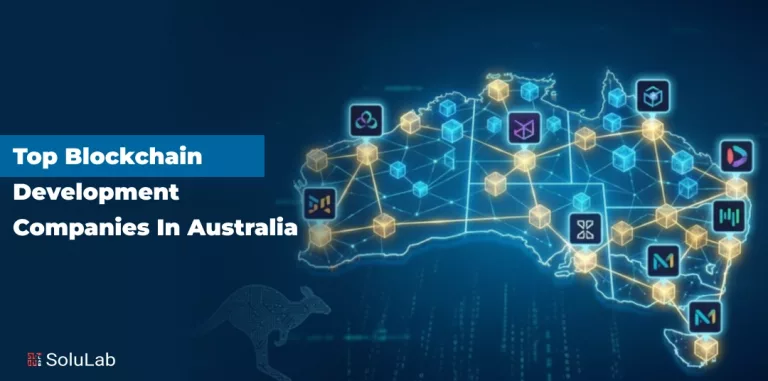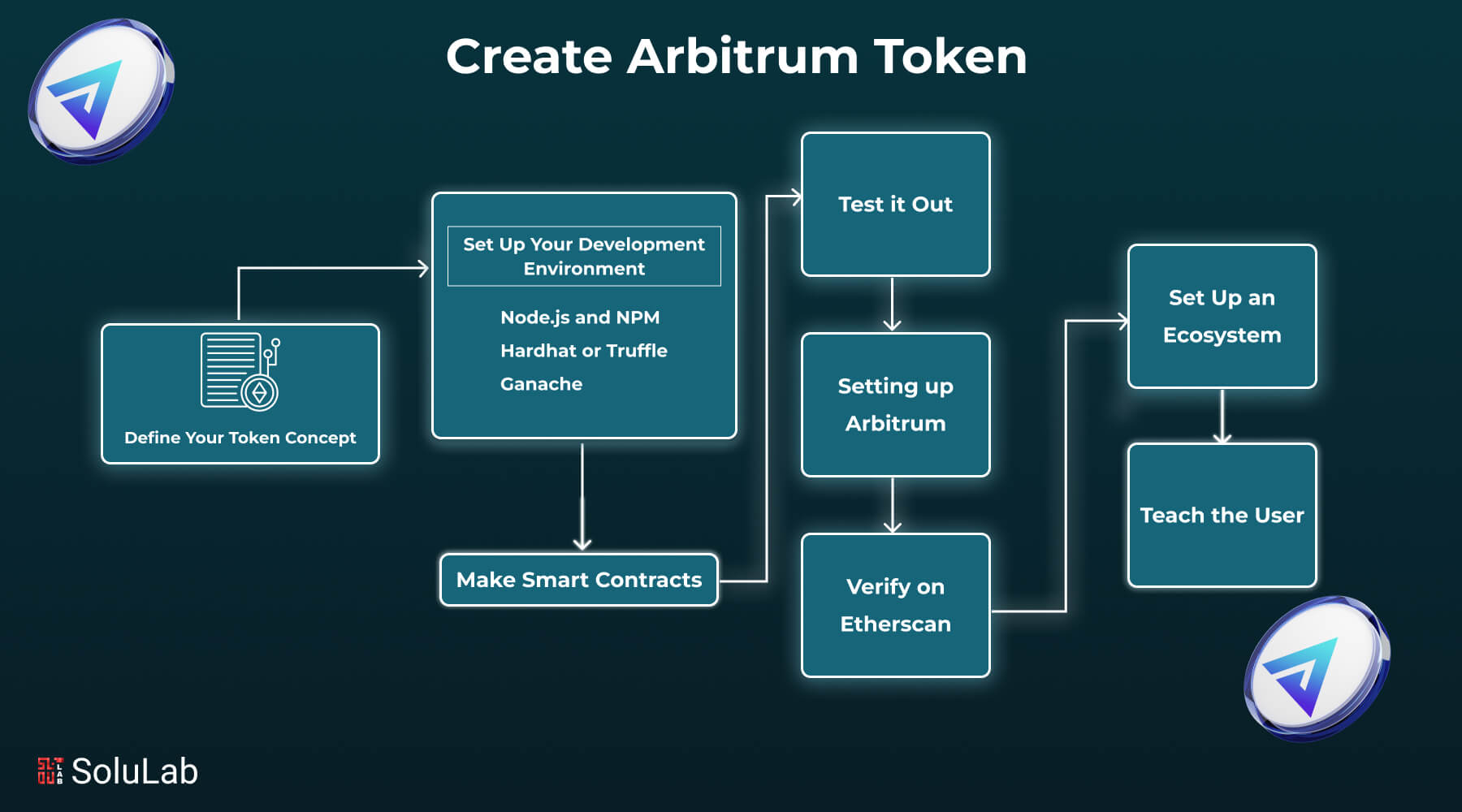
Arbitrum is a Layer 2 scaling option for Ethereum. Making a token on it has some great benefits, like lower transaction fees along quicker processing times. Plus, it makes it easier to use on a larger scale. Arbitrum also works with optimistic rollups. This way of growing decentralized apps is safe and effective.
Creating a wrapped token on Arbitrum could lead to a lot of new possibilities in the NFTs, and other areas. Seems hard? You can use crypto token creation services to help you get through the complicated process of making a token.
According to Dune’s figures, the daily average fees on Arbitrum went up by 97.8% this morning and are now $0.015 per transaction. Additionally, the average fees experienced a significant decline and currently remain at $0.007.
In this blog, we’ll help you understand what an Arbitrum token is, why it’s important, and how to create Arbitrum tokens as well. Let’s get started!
What are Arbitrum Tokens?
Arbitrum is a quick, private, and secure layer-2 platform for scalable smart contracts and cryptocurrencies. To increase the speed and effectiveness of Ethereum-based dApps, Arbitrum’s scaling approach makes use of Optimistic Rollups.
By running their Solidity contracts through the Arbitrum translator, developers can use rollup technologies to speed up and enhance the effectiveness of transactions. Arbitrum and Ethereum are connected via a component called “EthBridge,” which permits the free exchange of messages and utility tokens. Developers only need to elaborate to construct and launch their dApps using Moralis Speedy Nodes.
Why Create a Token on Arbitrum?
As it is in its entire development stage, its ERC20 layer 2 standards, cheap fees, minimal congestion, and appealing timing make building a token in crypto at Arbitrum a high-value alternative when selecting which crypto ecosystem we would launch our token from.
Although Arbitrum’s blockchain generates tokens with multiple applications, we may especially highlight some of them:
- Equity
- Payment Currency
- Exchanges
- Meme Coin
- Governance
- Contract’s Execution
Here are 3 reasons why developers should choose Arbitrum:
1. EVM Equivalence
The Ethereum Virtual Machine (EVM) is the computer system that keeps the Ethereum blockchain in sync and makes smart contracts work. As a way to support the EVM, Arbitrum groups thousands of transactions into single blocks. This slows down the mainnet’s processing power and lowers gas fees.
To do this, Arbitrum must maintain full EVM parity. This ensures that blocks finished on Arbitrum are the same as those finished on Ethereum’s mainnet.
EVM equivalence means that computer languages like Solidity and Vyper can be used to write Arbitrum smart contracts without making any changes.
This gives Arbitrum a significant advantage over other platforms, like Solana, which is a non-EVM blockchain and needs developers to know domain-specific programming languages and tools.
Arbitrum has reached the EVM equivalent with the help of Arbitrum Nitro. When it came out, Nitro was a major improvement over Arbitrum Classic. It uses WebAssembly (WASM) for low-level instructions to achieve high EVM compatibility, scaling, and lower transaction fees.
Geth, which is the most popular Ethereum processing client, is also used by Nitro. Geth makes it even easier for Arbitrum to work with the EVM.
2. Censorship Resistance
To make it possible for Arbitrum to work, sequencers must accept transaction requests from users, carry them out, and post the necessary data to Ethereum. Transactions are sent to a sequencer’s main address. Once transactions are submitted to the Layer 2 protocol, they are processed immediately and the results are published to the Ethereum mainnet within minutes.
Arbitrum does, however, have rules for when a program does something bad. To begin, the sequencer can only delay Ethereum posting deals. It can suggest fake deals because real ones need a user’s signature.
Second, users can force a transaction to be carried out if the sequencer doesn’t do it by putting it in the Delayed Inbox, which is a “first come, first served” list. The sequencer can’t skip this transaction without putting all the transactions that come after it behind schedule. With these methods, Arbitrum is harder to censor.
3. Consumer and Developer Ecosystem
Arbitrum’s ecosystem holds over 66% of the Ethereum market and a Total Value Locked (TVL) of $6.17 billion, making it the biggest L2 solution. This was confirmed on May 4, 2023. The number of live wallets and the cost of gas are also the lowest in the L2 ecosystem.
Because Arbitrum is the same as EVM, Ethereum builders can be used to develop apps that run on Arbitrum. Many popular protocols, such as Uniswap, The Graph, and Chainlink, also support Arbitrum because it has many cost and scale benefits.
Arbitron has also added new tools, like Stylus, that help developers make its processes bigger. A new programming environment and virtual machine called Stylus is built on WebAssembly and claims to offer an EVM+ paradigm.
On Arbitrum, written in Rust, C, and C++ will be able to be used by developers. This would make it easier for coders to use the EVM with other programs.
How Much Does it Cost to Create a Token on Arbitrum?
To create a token on Arbitrum, you must first construct a smart contract, which is essentially a code that stays on the blockchain and serves as the foundation for a certain digital asset. There is a smart contract behind the token, and you need to know how to code to build it.
It costs a lot to have a developer make a smart contract—often over $200. That’s why online solutions make it easier for everyone to live together in the cryptocurrency ecosystem by letting anyone who doesn’t know how to code make their token for as little as 0.01 ETH.
The dApps we’ll be using are called, and they charge only 0.01 ETH to use. Its main job is to make smart contracts.
Key Components of Arbitrum
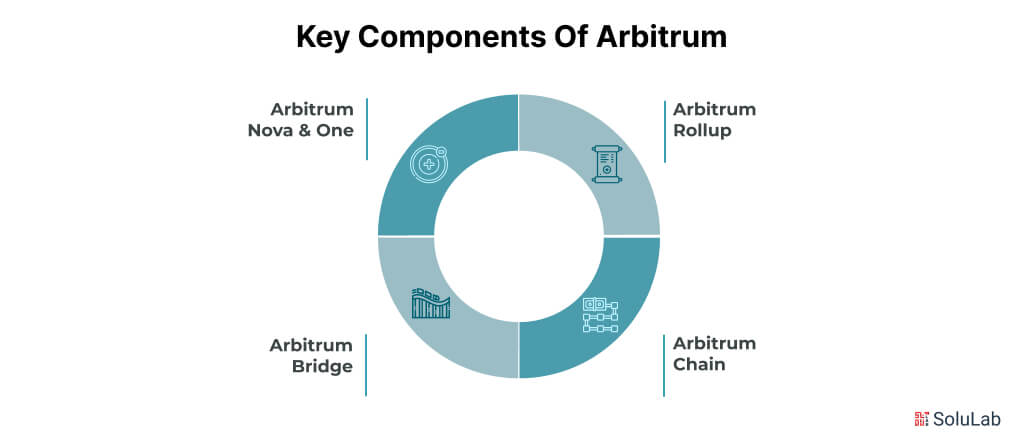
Here are some major key components of Arbitrum listed below:
Arbitrum is built based on tools and technologies that improve scalability, security, and usefulness. Arbitrum is a powerful Layer 2 solution for Ethereum. Here are some of its key components mentioned below:
1. Arbitrum Rollup
Using second-layer scaling technology to execute transactions off-chain and compile the outcomes onto the Ethereum mainnet, the Arbitrum Rollup is the pillar of the Arbitrum ecosystem. This approach lowers transaction fees and greatly releases Ethereum’s burden. Using fraud proofs that guarantee any inaccurate transaction can be disputed and fixed, the Rollup technology is meant to maximize throughput without compromising security. See the Arbitrum Ecosystem Review for a comprehensive study.
2. Chain of Arbitrium
Operating alongside the Ethereum mainnet, the Arbitrum Chain uses the Ethereum Virtual Machine (EVM) to help create and run smart contracts. This guarantees a complete fit with the Ethereum ecosystem, enabling developers to make use of current tools and resources. The improved process helps the chain as well since it speeds up transactions and lowers problems usually present on the Ethereum network.
3. Bridge of Arbitrium
Facilitating the transfer of assets including ETH and ERC-20 tokens between the Ethereum mainnet and the Arbitrum Chain, the Arbitrum Bridge links the two networks. This flawless integration improves asset management’s flexibility and user experience. The bridge enables secure and efficient transfer of assets between systems, reducing delays and improving both liquidity and cross-system compatibility.
4. Arbitrum Novae and Arbitrum One
Arbitrum Nova is a public Any Trust chain; Arbitrum One is a public Roll-up chain. Both give alternatives for several use cases and unique scaling methods with differing trust assumptions. Arbitrum One is geared toward high quantities systems with a higher level of trustlessness, while Arbitrum Nova is geared toward applications that require lower expenses and can accept a semi-trusted configuration.
Benefits of Creating Tokens on Arbitrum
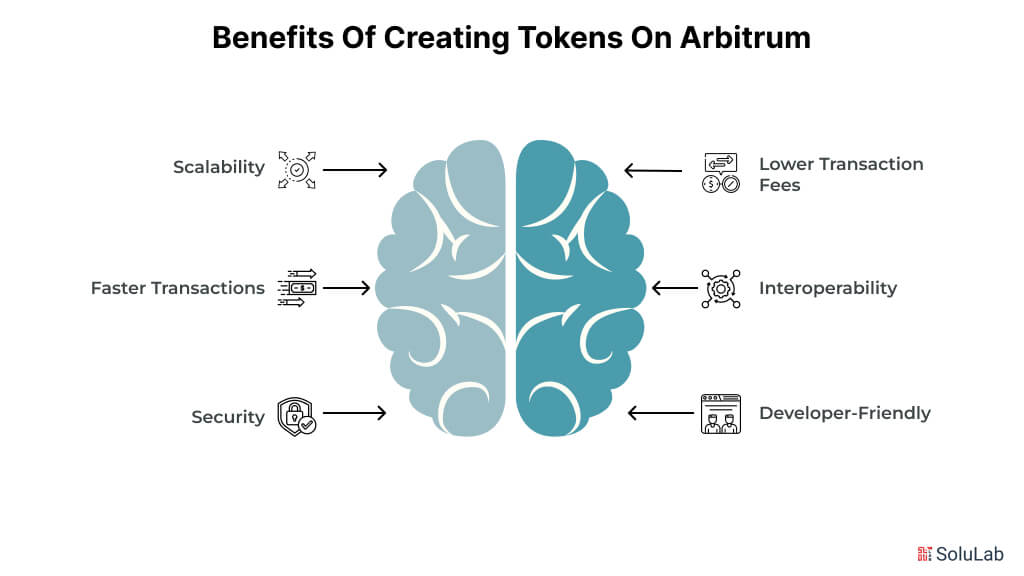
Arbitrum comes with numerous advantages that can boost how well your decentralized applications (dApps) perform and how enjoyable they are for users. Let’s break it down:
1. Scalability
Arbitrum uses Layer 2 scaling solutions, which means it can process way more transactions than Ethereum’s mainnet. This helps avoid network congestion, letting your app handle more users smoothly. The result? Happier users are more likely to stick around.
2. Lower Transaction Fees
One of Arbitrum’s biggest draws is its lower gas fees. By deploying tokens here, you’re saving users money, especially on smaller transactions. This affordability often leads to higher transaction volumes—great for driving business growth.
3. Faster Transactions
Speed matters. Transactions on Arbitrum are noticeably faster than on Ethereum’s mainnet. For apps that rely on real-time interactions, this is a game-changer. It keeps users engaged and makes their overall experience much better.
4. Interoperability
Arbitrum is Ethereum-compatible, meaning you can use the same tools and libraries you’re already familiar with. Migrating or launching tokens is straightforward, saving you time and cutting down on development costs.
5. Security
Because Arbitrum is built to inherit Ethereum’s security, you get the best of both worlds: high performance and strong protection. This reassurance helps build trust with your users, which is key to growing your project’s Security of Token Offerings.
6. Developer-Friendly
If you know your way around Ethereum, working on Arbitrum will feel second nature. The development environment is similar, which speeds up project timelines and reduces the learning curve, so you can launch your product faster.
How to Develop a Token on Arbitrum? A Step-by-Step Guide
Follow this step-by-step guide to create your token on Arbitrum:
Step 1: Come up With an Idea for Your Token
First, you need to think about what your token is for before you get into the technical stuff. First, ask yourself these important questions:
- What will your token do to help?
- What kind of token will it be? Is it going to be an NFT, a real estate tokenization, or something else?
- How many tokens will there be, and how will they be given out?
If you can answer these questions, you will save time and find it much easier to talk to crypto token makers. It also helps developers make sure that the ecosystem around your token fits exactly with your project’s goals and what your audience expects.
Step 2: Make Sure Your Development Environment is Ready
You’ll need to set up a reliable development setup before you can make a token on Arbitrum. This is what you need to use:
- Node.js and NPM: Used to keep track of packages and tools.
- Frameworks like Hardhat or Truffle: Let you build and run smart contracts.
- Ganache: A local Ethereum blockchain that lets you test your contracts.
Don’t forget to set up a wallet that works with it either. You can keep track of transfers while working on your token with MetaMask or WalletConnect.
Step 3: Make Smart Contracts
This step is the most important part of making a token. Smart contract platforms tell your token how to work and handle everything from payments to creating new tokens and burning old ones. Hiring a token development business with a lot of experience can make this process easy. Here are some important features that smart contracts usually have:
- Mint: To make fresh coins.
- Burn: To get rid of tokens and lower the quantity.
- Move: To move tokens from one person to another.
- Give permission and moveFrom: So that one person can spend tokens for another user.
To avoid bugs or security problems in the future, it’s important to get these features right.
Step 4: Test it Out
It’s time to test your smart contracts fully once they are finished. Run unit tests and use tools to try out different situations. The goal is to find any security holes or mistakes in the logic so that your token works perfectly and doesn’t pose any surprising problems or security risks.
Step 5: Setting up Arbitrum
Once testing goes well, it’s time to put your token to use on the Arbitrum network. Frameworks like Hardhat and Truffle can help make release easier, no matter if you use the telnet or the mainnet. Still, it’s best to let experienced crypto token writers take care of this important step since it comes with its risks.
Step 6: Check Etherscan
Once your contract is live, check it on Arbitrum’s Etherscan. This step makes things more clear by letting people see the code for your contract and the details of the exchange. It also makes people trust your project, which makes them more likely to use your token.
Step 7: Set Up an Ecosystem
Putting your token to use is only the beginning. To make sure it works in the long run, you’ll need to build a healthy ecosystem. To do this, you need to form partnerships, connect your token to DeFi platforms, offer liquidity, and run marketing efforts to get the word out about your token. Use social media and platforms to stay involved in the community and build and keep a loyal user base.
Step 8: Teach the User
As a token maker, your work doesn’t end when the tokens are sent out. People will need to be taught how your token works. To explain how to buy, sell, and use your token, you should usually make a white paper, a list of frequently asked questions (FAQs), and guides. Working with a token development company with a lot of knowledge can help you put this together. You can build trust and keep your group involved by being open about risks and your project roadmap.
Prerequisites for Token Development on Arbitrum
Before starting the process of asset tokenization creation, token developers need to take a few important steps to get ready:
1. Needs for Technology
- Knowledge of the basics of blockchain
- Strong computer skills
- Know how Ethereum and Layer 2 systems work
- Knowing how to make smart contracts
- Know about the guidelines for tokens (ERC-20, ERC-721, etc.)
2. Planning for the future
- Make the use and value of tokens clear.
- Figure out coin economics
- Outline the framework of tokenomics
- Figure out the target market and possible uses.
- Write an in-depth white paper.
Challenges of Creating Tokens on Arbitrum
Here are some challenges listed below you should be aware of before creating a token:
1. Setting up Everything
Setting up a development environment is essential to use smart contracts on Arbitrum, but it can be challenging for new developers. To get started, you need to configure tools like Remix, Hardhat, or Truffle and connect MetaMask to the Arbitrum network. This process can be daunting, especially for those unfamiliar with Ethereum development.
2. Security
While Arbitrum offers many benefits, it also comes with security challenges. Developers must be cautious when working with older versions of Solidity to avoid vulnerabilities like reentrancy attacks and overflow/underflow issues. Before deploying contracts on the mainnet, thorough testing on testnets like Arbitrum Goerli is essential. Staying updated on the latest security best practices and conducting meticulous audits of smart contracts are crucial steps to mitigate risks.
3. Governance and Risks of Upgrades
Smart contract updates and modifications are managed by the Arbitrum DAO and the Security Council. Although this governance model includes timelocks and delays to enhance safety, there are still malicious code changes if they are not properly reviewed. The Emergency Security Council can bypass these delays, adding complexity to the governance process. While this system provides a safety net, it demands transparency and trust within the community.
4. Dependency on Ethereum
The Ethereum network plays a critical role in how Arbitrum functions. Although Arbitrum is a Layer 2 solution designed to enhance scalability, issues or congestion on the Ethereum and Smart contract mainnet can impact its performance and security. Consequently, while Arbitrum helps improve scalability, it remains tied to the limitations and challenges of the Ethereum network.
Conclusion
Using Arbitrum to make tokens has big benefits for both devs and users. Arbitrum is a Layer 2 scaling solution for Ethereum. Its optimistic roll-up technology combines the security of the Ethereum main net with better scalability, lower transaction fees, and faster processing times.
You can greatly improve your chances of success if you clearly explain the reason for your token, follow the rules, test it thoroughly, and build a community around it. Additionally, crypto token development services would be able to offer knowledge and help during the tough process of token creation.
SoluLab helped Token World, a crypto launchpad, simplify token sales and enhance blockchain projects’ transparency. With a focus on smart contract security, regulatory compliance, scalability, and community building, Token World sought expert solutions. We helped them by implementing secure smart contracts, ensuring compliance, and developing scalable infrastructure.
Additionally, we designed tokenomics strategies to mitigate market volatility and community engagement, enabling Token World to token launches and provide a seamless experience for both investors and project creators. SoluLab, a Token development company, has a team of experts to help your business solve your business problems. Contact us today.
FAQs
1. What is Arbitrum and how does it work?
An Arbitrum token maker is a piece of software that makes it easier to make tokens. It automatically writes smart contracts and places NFT token services on the Arbitrum network. By providing a guided interface, these platforms let you change things about tokens, like their name and the total supply. Once set up, the puts your coin on Arbitrum, which saves time and makes it less necessary to know a lot about technology.
2. How can I make an Arbitrum token if I don’t know how to code?
You don’t need to know how to code to use an Arbitrum token maker to make a token. These tools have easy-to-use interfaces that let you change the name, symbol, and amount of your token. The technical parts are taken care of by platforms like TokenMint or similar generators, which let you use Arbitrum to launch your token quickly and easily.
3. What will happen if I send my money to an exchange that doesn’t accept Arbitrum?
Your money can disappear or become untraceable. Before sending money, you should always make sure that the exchange you are sending it to is accepted by Arbitrum. If you make a mistake and make such a transaction, you should contact the exchange’s help team Solana Token Services.
4. Why do I need ETH to use the Arbitrum network?
On the Arbitrum network, too, you need ETH to pay for transaction fees, just like on Ethereum. It makes sure that transfers go through, smart contracts work as planned, and the network stays safe and useful.
5. Do I need to pay a tip or priority fee for my Arbitrum transactions?
No, Arbitrum transactions don’t require tips or priority fees. With lower gas fees than Ethereum, the network operates efficiently, ensuring quick and cost-effective transaction processing without the need for additional payments to prioritize them.



